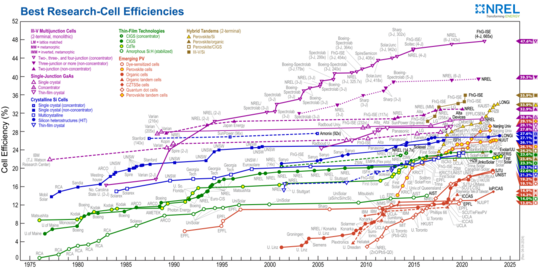
Solar-cell efficiency is the portion of energy in the form of sunlight that can be converted via photovoltaics into electricity by the solar cell.
The efficiency of the solar cells used in a photovoltaic system, in combination with latitude and climate, determines the annual energy output of the system. For example, a solar panel with 20% efficiency and an area of 1 m2 will produce 200 kWh/yr at Standard Test Conditions if exposed to the Standard Test Condition solar irradiance value of 1000 W/m2 for 2.74 hours a day. Usually solar panels are exposed to sunlight for longer than this in a given day, but the solar irradiance is less than 1000 W/m2 for most of the day. A solar panel can produce more when the Sun is high in Earth's sky and will produce less in cloudy conditions or when the Sun is low in the sky; usually the Sun is lower in the sky in the winter.
Two location dependant factors that affect solar PV yield are the dispersion and intensity of solar radiation. These two variables can vary greatly between each country.[1] The global regions that have high radiation levels throughout the year are the middle east, Northern Chile, Australia, China, and Southwestern USA.[1][2] In a high-yield solar area like central Colorado, which receives annual insolation of 2000 kWh/m2/year,[3] a panel can be expected to produce 400 kWh of energy per year. However, in Michigan, which receives only 1400 kWh/m2/year,[3] annual energy yield will drop to 280 kWh for the same panel. At more northerly European latitudes, yields are significantly lower: 175 kWh annual energy yield in southern England under the same conditions.[4]

Several factors affect a cell's conversion efficiency, including its reflectance, thermodynamic efficiency, charge carrier separation efficiency, charge carrier collection efficiency and conduction efficiency values.[6][5] Because these parameters can be difficult to measure directly, other parameters are measured instead, including quantum efficiency, open-circuit voltage (VOC) ratio, and § Fill factor. Reflectance losses are accounted for by the quantum efficiency value, as they affect "external quantum efficiency". Recombination losses are accounted for by the quantum efficiency, VOC ratio, and fill factor values. Resistive losses are predominantly accounted for by the fill factor value, but also contribute to the quantum efficiency and VOC ratio values.
As of 2024, the world record for solar cell efficiency is 47.6%, set in May 2022 by Fraunhofer ISE, with a III-V four-junction concentrating photovoltaic (CPV) cell.[7] This beat the previous record of 47.1%, set in 2019 by multi-junction concentrator solar cells developed at National Renewable Energy Laboratory (NREL), Golden, Colorado, USA,[8] which was set in lab conditions, under extremely concentrated light. The record in real-world conditions is held by NREL, who developed triple junction cells with a tested efficiency of 39.5%.[9][10]
- ^ a b Kannan, Nadarajah; Vakeesan, Divagar (1 September 2016). "Solar energy for future world: - A review". Renewable and Sustainable Energy Reviews. 62: 1092–1105. doi:10.1016/j.rser.2016.05.022. ISSN 1364-0321.
- ^ Köberle, Alexandre C.; Gernaat, David E. H. J.; van Vuuren, Detlef P. (1 September 2015). "Assessing current and future techno-economic potential of concentrated solar power and photovoltaic electricity generation". Energy. 89: 739–756. Bibcode:2015Ene....89..739K. doi:10.1016/j.energy.2015.05.145. hdl:1874/319865. ISSN 0360-5442. S2CID 108996432.
- ^ a b Billy Roberts (20 October 2008). "Photovoltaic Solar Resource of the United States". National Renewable Energy Laboratory. Retrieved 17 April 2017.
- ^ David J. C. MacKay. "Sustainable Energy - without the hot air". inference.org.uk. Retrieved 20 November 2017.
Solar photovoltaics: data from a 25-m2 array in Cambridgeshire in 2006
- ^ a b Kumar, Ankush (3 January 2017). "Predicting efficiency of solar cells based on transparent conducting electrodes". Journal of Applied Physics. 121 (1): 014502. Bibcode:2017JAP...121a4502K. doi:10.1063/1.4973117. ISSN 0021-8979.
- ^ "Photovoltaic Cell Conversion Efficiency Basics". U.S. Department of Energy. Retrieved 6 September 2014.
- ^ Schygulla, Patrick; Beutel, Paul; Heckelmann, Stefan; Höhn, Oliver; Klitzke, Malte; Schön, Jonas; Oliva, Eduard; Predan, Felix; Schachtner, Michael; Siefer, Gerald; Helmers, Henning; Dimroth, Frank; Lackner, David (2022). Quadruple Junction Solar Cell with 47.6 % Conversion Efficiency under Concentration. International Conference on Metal Organic Vapor Phase Epitaxy 2022.
- ^ Geisz, John F.; France, Ryan M.; Schulte, Kevin L.; Steiner, Myles A.; Norman, Andrew G.; Guthrey, Harvey L.; Young, Matthew R.; Song, Tao; Moriarty, Thomas (April 2020). "Six-junction III–V solar cells with 47.1% conversion efficiency under 143 Suns concentration". Nature Energy. 5 (4): 326–335. Bibcode:2020NatEn...5..326G. doi:10.1038/s41560-020-0598-5. ISSN 2058-7546. OSTI 1659948. S2CID 216289881.
- ^ Ozdemir, Derya (20 May 2022). "Scientists just broke the record for the highest efficiency solar cell". interestingengineering.com. Retrieved 7 August 2023.
- ^ France, Ryan M.; Geisz, John F.; Song, Tao; Olavarria, Waldo; Young, Michelle; Kibbler, Alan; Steiner, Myles A. (18 May 2022). "Triple-junction solar cells with 39.5% terrestrial and 34.2% space efficiency enabled by thick quantum well superlattices". Joule. 6 (5): 1121–1135. arXiv:2203.15593. doi:10.1016/j.joule.2022.04.024. ISSN 2542-4351. S2CID 247778421.